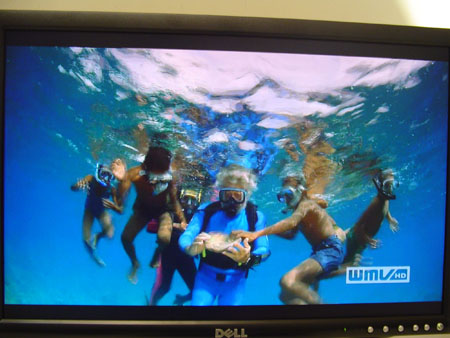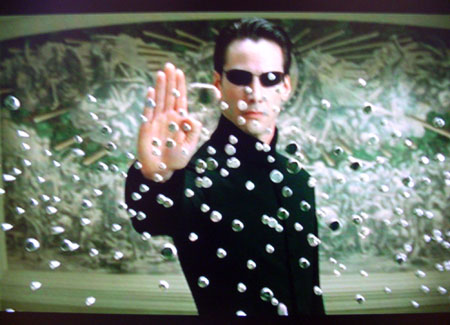The 20" LCD Shootout: Dell versus Apple
by Kristopher Kubicki on April 27, 2005 12:05 AM EST- Posted in
- Displays
Application Analysis
The core of our LCD benchmarking comes from real application analysis. We play with a lot of monitors and it gets easier for us each time to pick out problems with an LCD just by using the right application. Here are a few quick looks at some demanding full screen applications. We already ran ColorVision's OptiCal software, so all of our monitors are calibrated and adjusted to the same curves.High Definition Video – We played the WMV9 1080p and 720p versions of “Under Sea Adventure” to give our monitor a little taste of high definition video. In many of our previous analyses, we simply ran WMV9 content unscaled to test color depth and clarity. However, since both the Apple Cinema and Dell 2005FPW are capable of widescreen unscaled aspect ratios (at least for 720p), we thought it best to put both of these monitors completely through their paces. No surprise, but there doesn’t seem to be any corruption or shifts in any of the colors. However, keep in mind that neither of these displays supports HDCP! We could not watch 1080i or 720p signals on either display from a regular Comcast HD receiver, since neither display has a DVI-HDCP input. While pin compatible, any HDCP source simply terminates after a few seconds of video. The Dell 2005FPW has a few additional inputs, so we can actually use a component-to-VGA (15-pin D-sub) cable and watch HD content in this manner. Of course, for the same reason why we don’t encourage anyone to use 15-pin D-sub cables for regular computer use, we really don’t recommend D-sub for TV either if it can be avoided. Unfortunately, in this scenario, it cannot.
The Matrix Reload, The Matrix - We use the Matrix series to test full motion video on our LCDs. Since the Matrix isn't the best movie to test color reproduction, we typically only look for motion blur on gray-to-gray transitions or other imperfections in the signal. Both displays demonstrated accurate sharpness, although we noticed that the slightly duller Apple display had more of a “washed out” look to it in comparison to the Dell 2005FPW. Typically, we only see this on brighter LCDs with lower contrast ratios. Since the Apple 2005FPW has a (very) slight lower measured contrast ratio, this didn’t surprise us during out testing.
World of Warcraft – Although I didn’t personally start playing World of Warcraft until Anand published his Performance Guide, WOW happens to be one of the most perfect games to test LCD gaming. The fairly rich color palette, high motion objects and often contrasting lights and darks make the game a perfect haven to really put a display to its limits. (Unfortunately, once you turn it on, it also becomes nearly impossible to stop playing and start writing). Putting our displays into mirroring mode and playing for a few hours really stresses the importance of good color calibration in game settings; for example, it became almost impossible to differentiate portions of the grass needed to be selected for a quest on both LCDs before calibration through ColorVision’s OptiCal. Because both monitors were using DVI connectors, these changes had to be made to the color curves on the PC because the functionality is disabled on the monitors.
Max Payne 2 - The extreme light and dark transitions in Max Payne still provide us with the sufficient criteria to benchmark transient response time; specifically, we can focus on the light and dark extremes. We detected no red shift (as we usually do on this game for PVA displays), and had no problem with motion blur.
Photoshop CS – We typically don’t mention applications like Photoshop, but while using some of our new found desktop space, we took to advanced features in Photoshop like a fish in water. It’s no surprise that high end graphics (and, of course, video) are done on these displays; the higher resolution and wider room allow us to spread the tool bars out further while giving us more room to work. Widescreen displays feel awkward at first, but given hours of tinkering and readjusting, the additional room feels almost necessary.













70 Comments
View All Comments
cnlsilva - Thursday, April 28, 2005 - link
Thanks for the article - I have an LG/Phillips 1680x1050 display on my laptop and it is great. The only display I can see that could beat it would be tthe 1920x1200 display now on the Dell XPS Gen2 laptop. A review on that display would be nice.Two questions:
1. Anyone have any information on the 17" 1680x1050 display as separate units - I have DVI out so it would be nice to dual monitor - although that is a VERY wide dual display - too wide perhaps.
Loved the article - a few errors(please edit this and remove this statement):
page 10 "Unlike analogy" -> analog
page 10 "uses much simplier" -> simpler
Pastuch - Thursday, April 28, 2005 - link
Fantastic article.RE: Widescreen Gaming
I too found the Widescreengamingforum and was shocked that with simple registry changes you can adjust most games to the native resolution you desire. I play Halflife 2 (CS Source), Farcry, Warcraft 3:FT (DOTA), Doom 3, and Everquest 2 on my 2005fpw without any stretching issues.
This forum thread has over 90 pages of responces from Dell 2005fpw owners. The thread is actually a review. http://www.neowin.net/forum/index.php?showtopic=24...
stukafox - Thursday, April 28, 2005 - link
Has anyone been able to purchase this monitor at the listed price of $486.85 from the Dealtime link? I click on the 'BUY IT' and am directed to Dell's site, which lists the monitor at $749, less a 25% discount of $187.25, for a total of $561.75. This is far from the $486.85 listed at Deal Time.Any idea what's going on?
Ibrin - Thursday, April 28, 2005 - link
I run the website that was mentioned earlier (WSGF), http://www.widescreengamingforum.comI posted an article over on the AnandTech forums about this article. The author is quite mistaken, and most new games do support widescreen. If you'd like a bit more detail on some of the games that do support widescreen, you can hit the forum topic here:
http://forums.anandtech.com/messageview.aspx?catid...
If you'd like detailed info, including on to hack/mod some of your favorite games to run in widescreen, head on over to the WSGF
golemite - Thursday, April 28, 2005 - link
few things...1) world of warcraft does support 1680x1050 natively, surprised you didnt see this in the resolution settings
for other games check out widescreengamingforum.com
2) 16:10 is usually used for computer/laptop monitors because it is felt that 16:9 doesnt give u an adequate workspace. it is suppose to be the recommended aspect ratio for Longhorn as well
3) dell will actually replace your LCD for any reason, even down to 1 pixel or backlighting problems within 21 days or so of purchase as part of their total satisfaction guarentee (or similarily named policy) many early adopters have apparently done this successfully
JNo - Wednesday, April 27, 2005 - link
oh yeah - thanks Sandys (#37 & 39) - that rocks! really helpful and saved me a lot of time...got a modded xbox with monster component, so it's getting even more tempting... just need to find a friend willing to contribute to getting the two at the discount...
JNo - Wednesday, April 27, 2005 - link
Also, I am guessing that the panel in the Dell 2405 may be the same one as in Sony's P-234/B (23" 1920x1200 widescreen, 16ms response time) reviewed here:http://www.gamepc.com/labs/view_content.asp?id=son...
Can anyone confirm?
djbkim - Wednesday, April 27, 2005 - link
My guess is that Dell LCDs are compatible with Macs. Dell's website has only PC compatibility listed.djbkim - Wednesday, April 27, 2005 - link
MJA - Wednesday, April 27, 2005 - link
at one time the dell 2005FPW was selling for $386 (techbargains.com codes)I got mine for $486